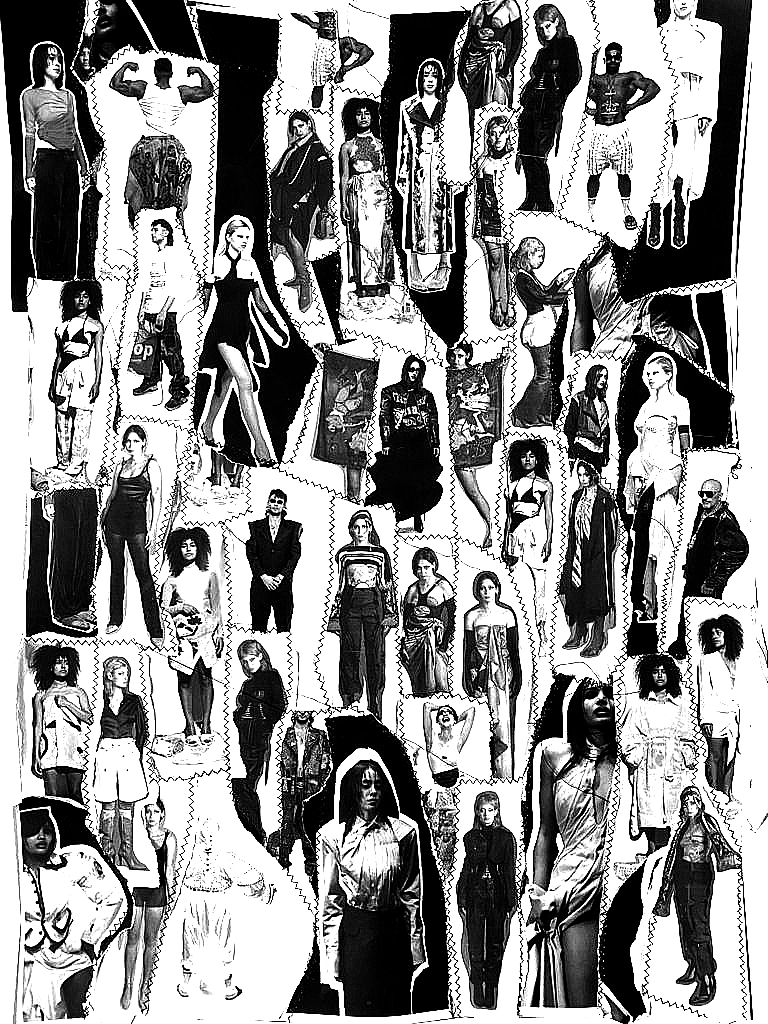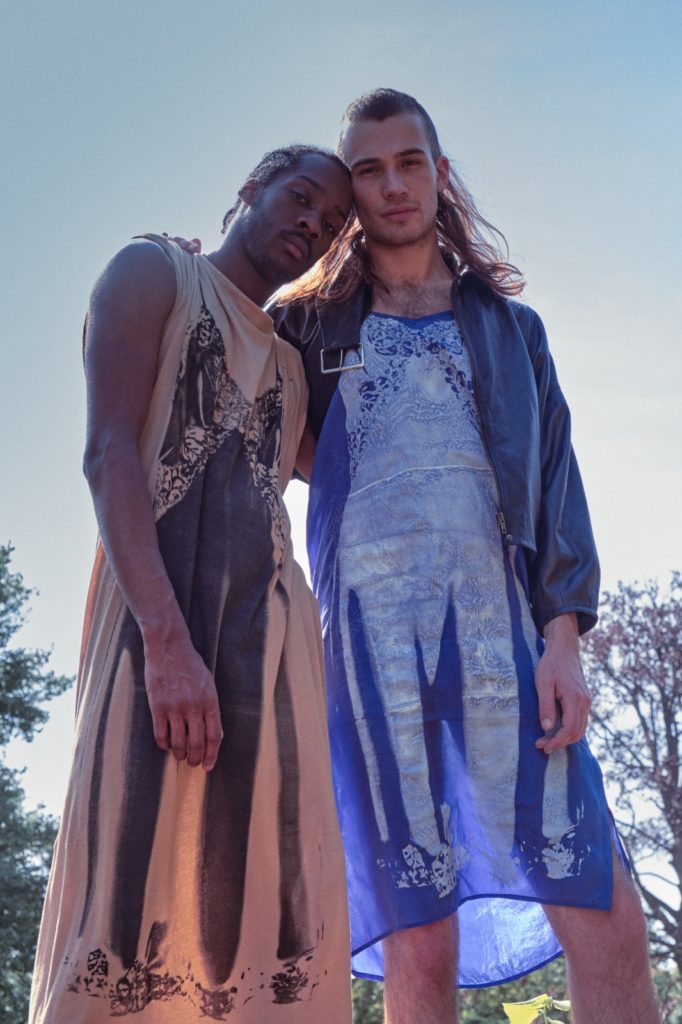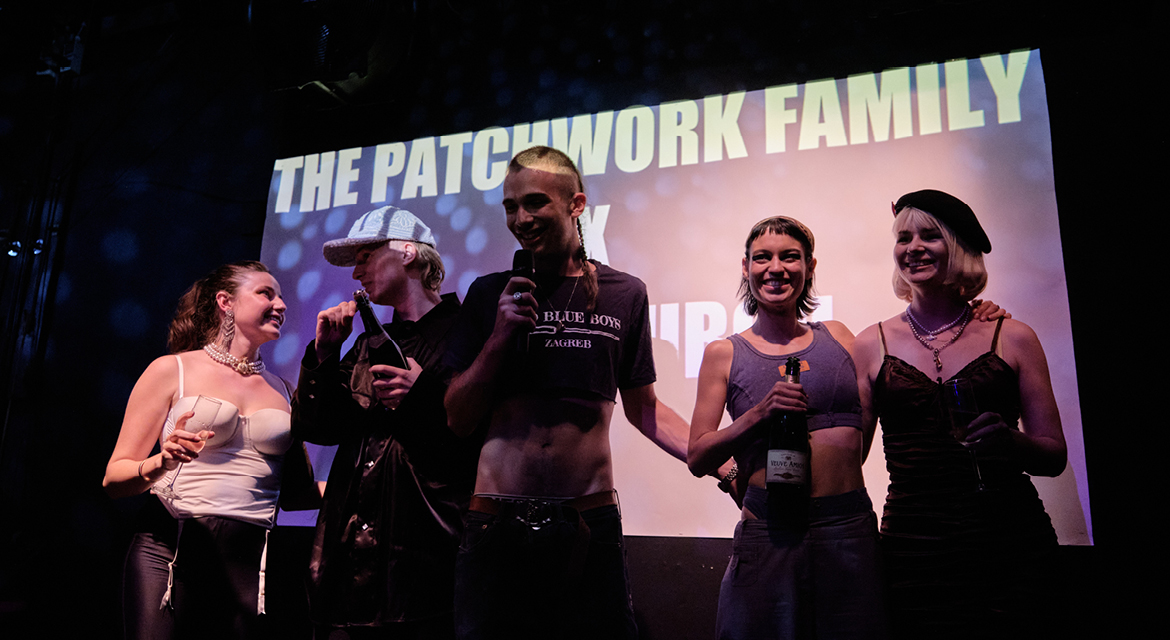From designing a full-blown collection for Dutch fashion brand HUMANOID in three weeks, to hosting their biggest solo show event to this date in Club Church; Patchwork Family is on its way to become one of the first successful democratic fashion collectives in the scene. We sat down with Liselot Hoekstra, Meike van Lelyveld, Marco Blazevic, Wolter Pot, Rachel Klok and Kenza Iatrides for their first interview as a group and tried to find out why they work so seamlessly together.
How did you guys become friends?
Meike: “We were all in the same class at ArtEZ except for Liselot who joined a bit later in the game. She did an internship with me for Eurovision, and helped us with the project in Museum Boijmans Van Beuningen since she has a lot of experience with videography. In this way, Liselot became friends with everyone and joined as an official member of the Patchwork Family.”
Marco: “During our education, we have been bonding, sharing our ups and downs and developing the beginnings of what we now call the Patchwork Family. I think it’s incredible what we’ve learned from each other.”
Meike: “Since I took a gap year, I didn’t graduate with the rest of the group and really missed out on the trust and support they were able to give to each other during their graduation moment. Seeing them all go to each other’s tables to ask for help, taking in consideration everyone’s skills and working together as a group was something we had to continue.”
Can you each introduce one of the team members? How do you see them and their design practice?
Meike on Liselot: “I think Liselot is very good at thinking along with other’s ideas. She has the ability to feel what other people want and to support them in the best way possible.”
Liselot on Meike: “Meike is really good at producing, and knows what it’s like to work in the fashion industry as a manager. We don’t have anyone else in the group like that and so that’s a very valuable asset for us.”
Marco on Kenza: “Kenza has a truly special way of designing. She makes everything very easy and accessible and comes up with fast upcycling solutions. Where we tend to think of way more complicated ways of working, Kenza just needs a few seems to make a garment look amazing. It also trickles down in her way of dressing herself. She layers a lot and wears things upside down just to create new interesting fits.”
Kenza on Rachel: “What’s amazing about Rachel is that’s she’s really sharp. Every time we have doubt, we go to Rachel because she always knows what to do. She brings a sense of couture to the mix and makes very complicated designs seem effortless. What she shows out there, it’s very cinematographic, that’s what makes her so authentic.”
Rachel on Marco: “Marco is a very autonomous designer. He’s focus is on conveying a certain message with his work. Therefore, everything he puts out has close correlations to the person he is. Mostly, he understands his people, and he does everything in a majestic sense. It’s always extremely thought-through and emotional.”
Everyone on Wolter: “How he uses upcycling is fresh and effortless. We all have a very fixed aesthetic, however Wolter can make garments for everyone in all stages of life because he has such a good idea on general aesthetics and a great commercial eye. He’s the typical Dutch designer; very conceptual but digestible, very straight-forward. We always trust his opinions as his knowledge of the fashion industry in general is extremely broad.”

When was the moment you realised you had something valuable in your hands with Patchwork Family?
Marco: “I had it right after the Club Church event. Absorbing the atmosphere we had created, I knew we did something special. Lots of people came to us during the event and said they didn’t see a show like this in 30 years. I understood then that we can do something not many others can do. The collective vibe of it was very special.”
Meike: “The first night we started designing the HUMANOID collection was very scary for me. We had to make so many garments, but the moment we had the first look ready we went through the process effortlessly. This initial satisfaction and the ease I felt in that moment made me realise the value of our collective.”
Kenza: “When we knew who was going to do what without even talking about it, that’s the moment I felt we could do this together.”
This year, you designed a capsule collection for Dutch fashion brand HUMANOID. For this collaboration, you decided to divide the members by strength instead of by garment, having to work together on certain garments as a team. Can you tell me something about this process?
Marco: “HUMANOID actually started in Arnhem in the 80s as something similar to what we tried to create with the Patchwork Family. Therefore, we decided use their first collection as our inspiration, as it felt close to home, and later added our own collective story to it. This common objective made this way of working together feel very natural. We also got an extreme amount of support from HUMANOID. They never told us what to do, but when we have doubt, the brand director would jump in and help us out. This trust and support made for a very fulfilling collaboration.”
Meike: “What really worked is that we had a starting point to add our own conceptual layer to. If we had to start from scratch, we would’ve had a lot of conflicting concepts. The freedom that was granted to us by HUMANOID was also what made this such a good collaboration.”

How does designing for a big brand differ from designing for your own brand?
Meike: “With HUMANOID, we had the luxury of working with a brand that has a heritage; a solid base of values and a commercial framework. Now, we’re working on the second HUMANOID collection and are getting used to this commercial decision-making process. We know what sold well from the last collection for example and take this in consideration when designing the new collection. In a way this limits your creativity, but it also makes the design-process less stressful in comparison to that of my own collection. It’s nice that HUMANOID tells it straight up and gives us a lot of room to learn, without any pressure.”
Rachel: “It’s definitely easier to design for a big brand than starting from point zero like with our own brands. It’s also a huge benefit to design for a brand that already has an established target group.”
Wolter: “The design process feels a bit more anonymous, and because we work together on this, none of us felt the need to push our own design identity or way of working. It’s a collective effort which is of course very different from designing our own individual collections.”
You recently had your biggest showcase so far, presenting each of your new collections in Club Church. Can you describe this night in one sentence?
Meike: “Wild, free and fun! The crowd really felt like they could be themselves and that for me was very special. It wasn’t about being seen or to behave in a certain way.”
Kenza: “The day itself was very exciting. Any other time we showed our work at school it always felt like it was the end of something. However, this event felt more like the beginning of something.”
Marco: “We always hope that everything we do is democratic and immersive, never really knowing what that means. With the Club Church event, we found out what that could actually entail. The door policy for instance was very democratic, not taking in consideration this elitist “tralala whatever” that often comes with a fashion show. That’s also why I believe the crowd was so weird and diverse. The audience was part of the show, everything was interacting with each other and that was so special.”

Can you all think of a brand/designer you aspire to collaborate with?
Meike: “For me, it’s important that there’s a heritage or story behind the brand. I believe any established luxury brand with a wide range and a big story could work!”
Marco: “I’m really obsessing over non-classical collaborations. My dream at the moment is to work with Decathlon and create something really unexpected.”
Kenza: “I would really like to work with a brand that doesn’t necessarily fit our aesthetic. I also do wonder how it would be to work with a brand that also upcycles.”
With your recent outing came the announcement you will be recruiting new Patchwork Family members. What are your criteria when it comes to new designers?
Meike: “A focus on upcycling is definitely important to us. We’re all used to making all-round collections, and I think having a designer that’s focussed on one strength like jewellery or knitwear could also really work. Having the same vision for the future of the fashion industry is also something I would look for in a new team member.”
Marco: “I think it could be interesting to see if we can find someone that has other skills they would want to develop within our collective, such as photography or film. Kenza is doing a lot with the web shop for instance, and these extra strengths are a big asset for our team. We are still a very open and fluid thing and I think it’s important to consider any new designer’s needs. I would like for people to come in and express what they want to achieve so we can facilitate that as well and grow together. “
Meike: “We want to have an open call now, so anyone that wants to join can reach out. We want to internationalise in the future, to make the process as democratic as possible.”
